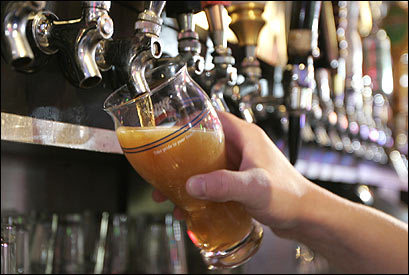from http://www.boston.com/yourlife/articles/2007/06/20/with_new_design_foam_follows_function/
| THIS STORY HAS BEEN FORMATTED FOR EASY PRINTING | |
With new design, foam follows functionBuild a better mousetrap, Emerson observed, and the world will beat a path to your door. Build a better beer glass, and first you'll need a squadron of scientists, engineers, and other experts versed in such concepts as nucleation site , volume-to-surface ratio, foam retention, and profile-attribute analysis method. This is exactly what Boston Beer Company president Jim Koch has done. His company, which brews Samuel Adams , has commissioned a new type of beer glass, and it's starting to show up in bars and pubs. "Maybe 2 percent of beer drinkers wonder why no one's done it before -- and 98 percent wonder why anyone would bother to. It's now the number-one selling item at our brewery," says Koch, whose gift shop sells shirts, caps, mugs, and other Sam Adams-branded gear along with the new glasses, priced at $8 each . Bold new design or brazen attempt to inject fresh fizz into an old product, the Samuel Adams Boston Lager Pint Glass was rolled out in February . According to Koch and others who worked on the project, it's the first beer glass created not by marketing experts or glass designers but by a brewer interested in one thing only: how beer tastes when poured into it. No one has challenged that claim, and no one is likely to, says Paul Pacult , a consultant on the project and editor of the Spirit Journal newsletter . "I've consulted on glass shapes for wine and whiskey," says Pacult. "But as far as beer goes, this is the first one designed specifically for a lager beer by people who aren't in the glass industry. And it definitely makes a difference in experiencing taste and aroma." Koch has already given and sold samples of the glasses in nearly a thousand bars from coast to coast. He doesn't deny there's a word -of-mouth marketing angle to his new glass. It's just not the kind most beer companies would come up with, he maintains. "In the sense that if the beer tastes better you sell more beer, yes," Koch says when asked if the new glass is a marketing ploy to sell lager. "But we're not trying to make money off this glass. Or introduce a new line of bar jewelry." Any data to measure whether it's boosted sales of Sam Adams? "None yet," says Koch. Appealing to suds snobs who embrace what might be called a microbrew mentality, the new glass has more curves than Josh Beckett throws in an eight-inning outing and includes features like a beaded rim ("creates turbulence, releasing aromas as beer enters mouth," according to a Sam Adams flier), outward-turning lip (to enhance "sweetness detection"), thinner walls to keep the brew colder in hand, and, if you can digest all this after a pint or two, a "nucleation site lasered into the bottom for increased hop aroma release." The glass can be found at taverns throughout the Boston area, where it's paired exclusively with Samuel Adams Boston Lager. Customer reaction at the Rattlesnake Bar & Grill has been positive, according to co-owner Tony Castagnozzi -- so much so that he has to keep replacing the glasses. "People are stealing them left and right," he says. At the Sunset Grill & Tap in Allston, owner Mark Kadish offers 112 different brews on tap, served in 60 kinds of beer vessel. The new glass "looks great, it's comfortable to hold, and it really does affect the taste," gushes Kadish. "And I'm a guy who'll happily drink beer out of a Dixie Cup." More than a year in the making, the new glass was inspired by a French wine expert who joined Koch's corporate board and convinced the brewmeister that glass design could do for a tasty lager what it does for a piquant syrah. Koch personally tested 150 varieties of beer glass before turning to Cambridge-based TIAX Laboratories to quantify the optimal lager-delivery system. Founded in 2002 , TIAX absorbed the remnants of Arthur D. Little Inc., a firm famous for its consumer-product research, after the latter folded. Its sensory team has been around since the 1940s, says TIAX technology marketer Jonaki Egenolf , and has worked with beer-making clients in the past, although mostly from a packaging standpoint. "This was unique, the first time anyone took a close look at beer glassware," Egenolf says. TIAX scientists began by establishing a flavor profile for Sam Adams lager in both bottles and kegs. They then compared 20 to 30 glass designs on features like rim angle and top diameter. Later they conducted a more in-depth study testing more than a dozen new designs before the final prototype was configured and turned over to a German glassmaker . "We were not wearing the hat of a consumer or industrial designer," Egenolf says. "Jim didn't want us to focus on aesthetics. It was all about qualities like 'mouth tingle.' " Feedback from bar owners has been mixed, Koch admits, because the glasses don't stack as neatly as conventional ones do. "That's OK," he says. "I didn't expect everyone would throw away their old glasses overnight. Besides, it really only works with bigger, more flavorful beers. It will not make Natty Light taste like Sam Adams." It won't make Sam Adams Lager sell like Bud Light, either. Still, says Boston University marketing professor Patrick Kaufmann , "Beer has a huge social dimension to it. If you can get people talking about a familiar product in a new and positive way, you're tapping into marketing's single most important source for attitude change, which is word of mouth. Can a new glass do that? Maybe." Joseph P. Kahn can be reached at jkahn@globe.com. |

No comments:
Post a Comment